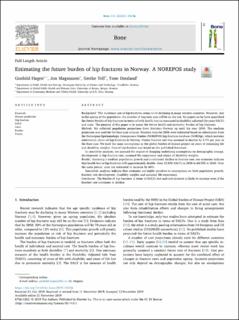| dc.contributor.author | Hagen, Gunhild | |
| dc.contributor.author | Magnussen, Jon | |
| dc.contributor.author | Tell, Grethe Seppola | |
| dc.contributor.author | Omsland, Tone Kristin | |
| dc.date.accessioned | 2020-08-26T09:21:12Z | |
| dc.date.available | 2020-08-26T09:21:12Z | |
| dc.date.created | 2019-12-17T13:19:42Z | |
| dc.date.issued | 2019 | |
| dc.identifier.issn | 8756-3282 | |
| dc.identifier.uri | https://hdl.handle.net/11250/2674324 | |
| dc.description.abstract | Background
The incidence rate of hip fractures seems to be declining in many western countries. However, due to the ageing of the population, the number of fractures may still be on the rise. No papers so far have quantified the future burden of hip fractures in terms of both health loss (as measured in disability adjusted life years DALY) and costs. The purpose of this paper is to assess the future health and economic burden of hip fractures.
Methods
We collected population projections from Statistics Norway up until the year 2040. The medium projection was used for the base case analysis. Fracture rates for 2008 were estimated based on information from the Norwegian Epidemiologic Osteoporosis Studies (NOREPOS) hip fracture database (NORHip), which includes information about all hip fractures in Norway. Future fracture rate was assumed to decline by 0.7% per year in the base case. We used the same assumptions as the global burden of disease project on years of remaining life and disability weights. Cost of hip fracture was based on the published literature.
In sensitivity analyses, we assessed the impact of changing underlying assumptions on demographic change, development in hip fracture rate, assumed life expectancy and choice of disability weights.
Results
Assuming a medium population growth and a continued decline in fracture rate, our estimates indicate that health lost to hip fractures will approximately double, from 32,850 DALYs in 2020 to 60,555 in 2040. Over the same period, costs are estimated to increase by 65%.
Sensitivity analyses indicate that estimates are highly sensitive to assumptions on both population growth, fracture rate development, disability weights and assumed life expectancy.
Conclusion
The burden of hip fractures in terms of DALYs lost and cost incurred is likely to increase even if the fracture rate continues to decline. | en_US |
| dc.language.iso | eng | en_US |
| dc.publisher | Elsevier | en_US |
| dc.rights | Navngivelse 4.0 Internasjonal | * |
| dc.rights.uri | http://creativecommons.org/licenses/by/4.0/deed.no | * |
| dc.subject | Helseøkonomisk evaluering | en_US |
| dc.subject | Health Economic Evaluation | en_US |
| dc.title | Estimating the future burden of hip fractures in Norway. A NOREPOS study. | en_US |
| dc.type | Journal article | en_US |
| dc.type | Peer reviewed | en_US |
| dc.description.version | publishedVersion | en_US |
| dc.subject.nsi | VDP::Epidemiologi medisinsk og odontologisk statistikk: 803 | en_US |
| dc.subject.nsi | VDP::Epidemiology, medical and dental statistics: 803 | en_US |
| dc.source.journal | Bone | en_US |
| dc.identifier.doi | 10.1016/j.bone.2019.115156 | |
| dc.identifier.cristin | 1761933 | |
| dc.description.localcode | © 2019 The Authors. Published by Elsevier Inc. This is an open access article under the CC BY license (http://creativecommons.org/licenses/BY/4.0/). | en_US |
| cristin.unitcode | 194,65,20,0 | |
| cristin.unitname | Institutt for samfunnsmedisin og sykepleie | |
| cristin.ispublished | true | |
| cristin.fulltext | original | |
| cristin.qualitycode | 1 | |

